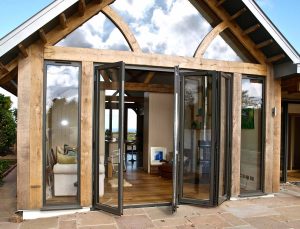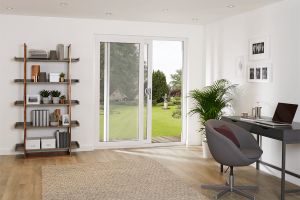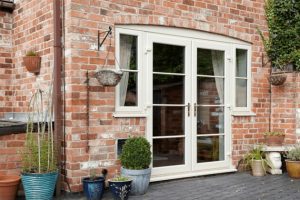When it comes to doors in the UK, there is more than one standard size. Understanding the various door dimensions is crucial for homeowners looking to improve their living space.
This handy guide from BSF Windows will cover standard UK door sizes for various types of doors, explain how door dimensions are measured, and provide tables of standard sizes for each door type. We’ll also discuss factors influencing door sizing, building regulations, accessibility requirements, custom sizing options, and how door sizes affect room functionality and aesthetics.
How Door Dimensions are Measured
Before we dive into specific sizes, it’s important to understand how doors are measured:
-
- Door Height: Measured from the top of the door to the bottom
- Door Width: Measured from one side of the door to the other
- Door Thickness: Measured from the front face to the back face of the door
Measurements are typically given in millimetres (mm) or feet and inches.
Standard Internal Door Sizes
Internal doors are the most common type found in UK homes. Here are the standard sizes:
Standard Internal Door Size Chart
| Metric (mm) | Imperial (inches) | Imperial (feet & inches) | Common Use |
|---|---|---|---|
| 1981 x 610 | 78″ x 24″ | 6’6″ x 2’0″ | Smaller rooms |
| 1981 x 686 | 78″ x 27″ | 6’6″ x 2’3″ | General use |
| 1981 x 762 | 78″ x 30″ | 6’6″ x 2’6″ | Most common |
| 1981 x 800+ | 78″ x 33″ | 6’6″ x 2’9″ | Wheelchair access |
The most common internal door size is 1981mm x 762mm x 35mm (6’6″ x 2’6″ x 1 3/8″). This size typically ensures a perfect fit for the most common door frame width in UK homes.
Standard External Door Sizes
External doors are typically larger and thicker than internal doors for security and insulation purposes.
Standard External Door Size Chart
| Metric (mm) | Imperial (inches) | Imperial (feet & inches) | Common Use |
|---|---|---|---|
| 1981 x 762 | 78″ x 30″ | 6’6″ x 2’6″ | Standard front door |
| 1981 x 838 | 78″ x 33″ | 6’6″ x 2’9″ | Wider front door (wheelchair accessible) |
| 2032 x 813 | 80″ x 32″ | 6’8″ x 2’8″ | Tall front door |
| 2032 x 900 | 80″ x 35.5″ | 6’8″ x 2’11.5″ | Large entrance or patio door |
Fire Door Sizes
Fire doors are available in standard internal door sizes, but the thickness of the door is increased to provide fire resistance:
-
- FD30 (30-minute fire rating): 44mm thick
- FD60 (60-minute fire rating): 54mm thick
Fire doors can be essential safety additions and must comply with strict regulations.
French Door Sizes
French doors are popular for creating a seamless transition between indoor and outdoor spaces. Standard sizes for French doors include:
| Total Width (mm) | Individual Door Width (mm) | Height (mm) |
|---|---|---|
| 1200 | 600 each | 2100 |
| 1500 | 750 each | 2100 |
| 1800 | 900 each | 2100 |
French doors are typically 44-54mm thick. Custom sizes are often available to fit specific openings.
Sliding Patio Door Sizes
Sliding patio doors come in various configurations, commonly 2, 3, or 4-panel designs. Standard sizes include:
| Number of Panels | Total Width (mm) | Height (mm) |
|---|---|---|
| 2 | 1800 | 2100 |
| 3 | 2400 – 2700 | 2100 |
| 4 | 3000 – 3600 | 2100 |
The thickness of sliding patio doors is typically 70-80mm to accommodate the sliding mechanism.
Bifold Door Sizes
Bifold doors offer flexibility regarding opening width and are available in various configurations. Common sizes include:
| Number of Panels | Total Width (mm) | Height (mm) |
|---|---|---|
| 2 | 1200 – 1500 | 2100 |
| 3 | 1800 – 2100 | 2100 |
| 4 | 2400 – 3000 | 2100 |
| 5 | 3000 – 3600 | 2100 |
| 6 | 3600 – 4200 | 2100 |
Bifold Door sizes depend on the material used but are typically 54-70mm thick.
Factors Influencing Door Sizing
Several factors can influence the required door size:
- Building regulations
- Accessibility requirements
- Property age and style
- Room function and size
- Furniture and appliance access needs
- Personal preference and aesthetic considerations
- Type of door
- Energy efficiency considerations (especially for external doors)
- Security requirements
Accessibility Requirements
Disability/accessibility doors should have a minimum clear opening width of 800mm. This typically requires a door leaf of at least 838mm wide.
How to Measure for a New Door
To measure for a new door:
-
- Measure the height from the top of the frame to the bottom
- Measure the width at the top, middle, and bottom of the frame
- Measure the thickness of the existing door
- For external doors, also measure the frame depth
Measuring for Specialised Door Types

Bifold Doors
-
- Measure the overall opening width and height
- Decide on the number of panels based on the opening size and desired panel width (typically 600-900mm)
- Allow for frame thickness and running track – 10-15mm on each side for the frames and deduct 35-50mm from the height for the top track

Sliding Doors
-
- Measure the width of the entire opening
- Determine the desired number of panels
- Account for the overlap of doors and frame thickness

French Doors
-
- Measure the width of the opening
- Decide whether you want equal-sized doors or a primary door with a smaller secondary door
- Account for frame thickness and any sidelights
Custom and Non-Standard Door Sizes
While standard sizes are common, many older properties or unique architectural designs may require custom door sizes. Custom sizes can be handy for:
-
- Period properties
- Unconventional room layouts
- Specific design requirements
- Accessibility adaptations
How Door Sizes Affect Room Functionality and Aesthetics
The size of a door can significantly impact both the functionality and appearance of a room:
Functionality:
- Wider doors improve accessibility and make moving furniture easier
- Taller doors can create a sense of spaciousness
- Narrower doors can help maximise wall space
Aesthetics:
- Door size should be proportional to the room and ceiling height
- Oversized doors can create a dramatic, luxurious effect
- Consistent door sizes throughout a property create a sense of harmony
Door type considerations:
- French doors can create a classic, elegant look and improve indoor-outdoor flow
- Sliding doors maximise views and natural light without requiring swing space
- Bifold doors offer flexibility in opening size.
When choosing door sizes, consider both the practical needs of the space and the overall design aesthetic you want to achieve.
Tips for Choosing the Right Door Size and Type
-
- Consider the room’s purpose
- Think about future needs, such as accessibility
- Balance aesthetics and functionality
- Ensure consistency with the property’s overall style
- Check building regulations, especially for fire doors and external doors
- Consider energy efficiency for external doors
- For patio areas, consider the balance between view, ventilation, and security
- In small spaces, sliding doors can save valuable floor space
- For large openings, weigh the benefits of bifold vs. sliding doors based on your specific needs
- Consider the impact of door size and type on natural light and ventilation
Remember that different manufacturers may vary in their door sizes. Always check the specifications of your chosen door carefully.

Professional Help from BSF Windows
Understanding the standard sizes and considerations for various door types is crucial when planning home improvements or new builds. From traditional interior doors to modern bifold systems, each type offers unique benefits and challenges in terms of sizing. By considering factors such as room functionality, aesthetic preference, and practical requirements, you can choose the right size door for each space in your home.
Proper measurement and consideration of building regulations are essential for ensuring your doors fit and comply with safety standards. Our interactive door designer tool can help you design your perfect new door.
At BSF Windows, our team of experts is ready to help you find the correct door for your next home improvement project. We provide high quality doors in various styles, types and materials. With more than 20 years of experience and with most products carrying a 10-year guarantee, we are readily equipped to help you at any stage of your project.
Contact us now at 01293 408 713, email us at bsfwindows@gmail.com or visit our beautiful showroom in Surrey.
